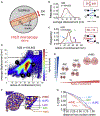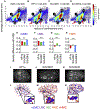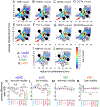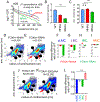Two-Parameter Mobility Assessments Discriminate Diverse Regulatory Factor Behaviors in Chromatin
- PMID: 32574554
- PMCID: PMC7483934
- DOI: 10.1016/j.molcel.2020.05.036
Two-Parameter Mobility Assessments Discriminate Diverse Regulatory Factor Behaviors in Chromatin
Abstract
Enzymatic probes of chromatin structure reveal accessible versus inaccessible chromatin states, while super-resolution microscopy reveals a continuum of chromatin compaction states. Characterizing histone H2B movements by single-molecule tracking (SMT), we resolved chromatin domains ranging from low to high mobility and displaying different subnuclear localizations patterns. Heterochromatin constituents correlated with the lowest mobility chromatin, whereas transcription factors varied widely with regard to their respective mobility with low- or high-mobility chromatin. Pioneer transcription factors, which bind nucleosomes, can access the low-mobility chromatin domains, whereas weak or non-nucleosome binding factors are excluded from the domains and enriched in higher mobility domains. Nonspecific DNA and nucleosome binding accounted for most of the low mobility of strong nucleosome interactor FOXA1. Our analysis shows how the parameters of the mobility of chromatin-bound factors, but not their diffusion behaviors or SMT-residence times within chromatin, distinguish functional characteristics of different chromatin-interacting proteins.
Copyright © 2020 Elsevier Inc. All rights reserved.
Conflict of interest statement
Declaration of Interests The authors declare no competing interests.
Figures





Similar articles
-
High mobility group proteins 14 and 17 can space nucleosomal particles deficient in histones H2A and H2B creating a template that is transcriptionally active.J Biol Chem. 1994 Nov 11;269(45):28436-42. J Biol Chem. 1994. PMID: 7961785
-
Nucleosome-binding affinity as a primary determinant of the nuclear mobility of the pioneer transcription factor FoxA.Genes Dev. 2009 Apr 1;23(7):804-9. doi: 10.1101/gad.1775509. Genes Dev. 2009. PMID: 19339686 Free PMC article.
-
The Paf1 complex factors Leo1 and Paf1 promote local histone turnover to modulate chromatin states in fission yeast.EMBO Rep. 2015 Dec;16(12):1673-87. doi: 10.15252/embr.201541214. Epub 2015 Oct 29. EMBO Rep. 2015. PMID: 26518661 Free PMC article.
-
Histone variants on the move: substrates for chromatin dynamics.Nat Rev Mol Cell Biol. 2017 Feb;18(2):115-126. doi: 10.1038/nrm.2016.148. Epub 2016 Dec 7. Nat Rev Mol Cell Biol. 2017. PMID: 27924075 Review.
-
Structure and Functions of Linker Histones.Biochemistry (Mosc). 2016 Mar;81(3):213-23. doi: 10.1134/S0006297916030032. Biochemistry (Mosc). 2016. PMID: 27262190 Review.
Cited by
-
Single nucleosome tracking to study chromatin plasticity.Curr Opin Cell Biol. 2022 Feb;74:23-28. doi: 10.1016/j.ceb.2021.12.005. Epub 2022 Jan 13. Curr Opin Cell Biol. 2022. PMID: 35033775 Free PMC article. Review.
-
Diverse heterochromatin states restricting cell identity and reprogramming.Trends Biochem Sci. 2023 Jun;48(6):513-526. doi: 10.1016/j.tibs.2023.02.007. Epub 2023 Mar 27. Trends Biochem Sci. 2023. PMID: 36990958 Free PMC article. Review.
-
Carm1-arginine methylation of the transcription factor C/EBPα regulates transdifferentiation velocity.Elife. 2023 Jun 27;12:e83951. doi: 10.7554/eLife.83951. Elife. 2023. PMID: 37365888 Free PMC article.
-
Multi-Scale Imaging of the Dynamic Organization of Chromatin.Int J Mol Sci. 2023 Nov 4;24(21):15975. doi: 10.3390/ijms242115975. Int J Mol Sci. 2023. PMID: 37958958 Free PMC article. Review.
-
Single-molecule tracking (SMT): a window into live-cell transcription biochemistry.Biochem Soc Trans. 2023 Apr 26;51(2):557-569. doi: 10.1042/BST20221242. Biochem Soc Trans. 2023. PMID: 36876879 Free PMC article.
References
-
- Bryan LC, Weilandt DR, Bachmann AL, Kilic S, Lechner CC, Odermatt PD, Fantner GE, Georgeon S, Hantschel O, Hatzimanikatis V, et al. (2017). Single-molecule kinetic analysis of HP1-chromatin binding reveals a dynamic network of histone modification and DNA interactions. Nucleic Acids Res. 45, 10504–10517. - PMC - PubMed
Publication types
MeSH terms
Substances
Grants and funding
LinkOut - more resources
Full Text Sources
Molecular Biology Databases
Research Materials

